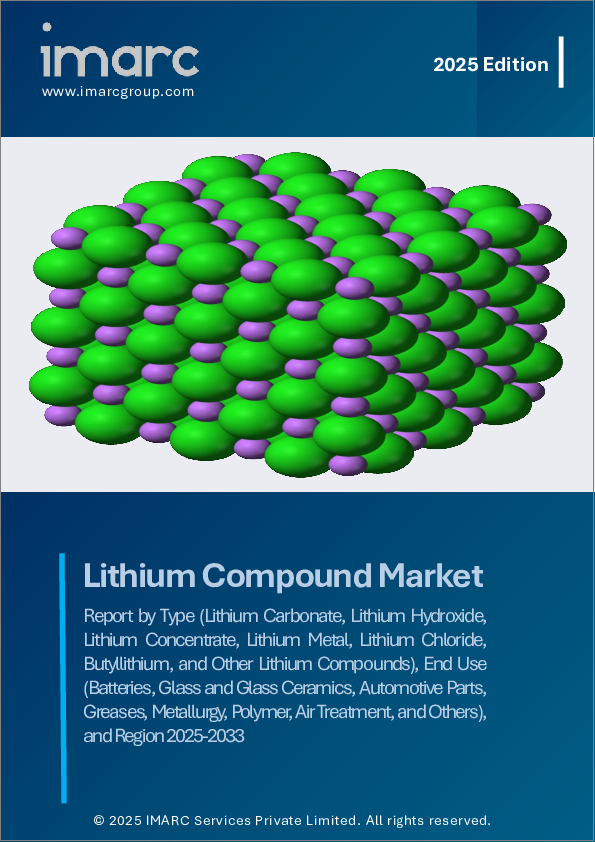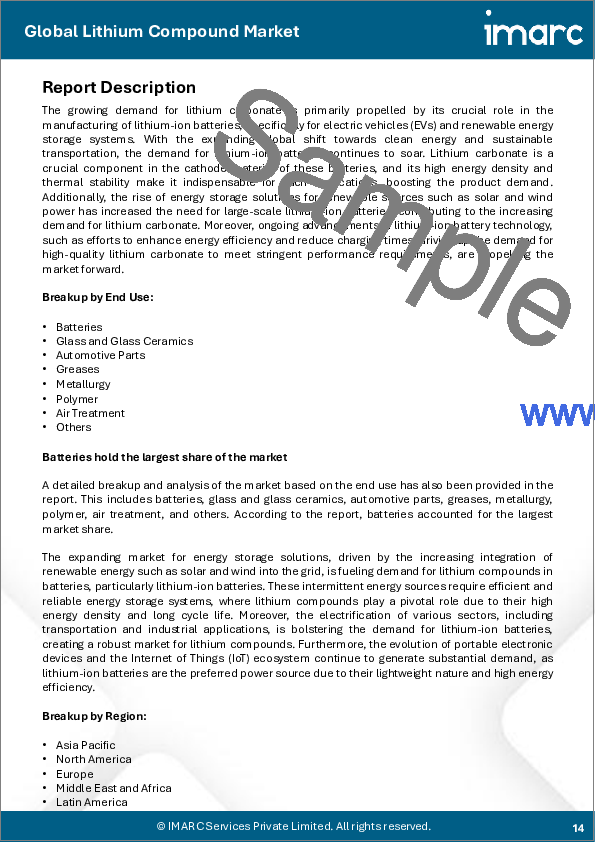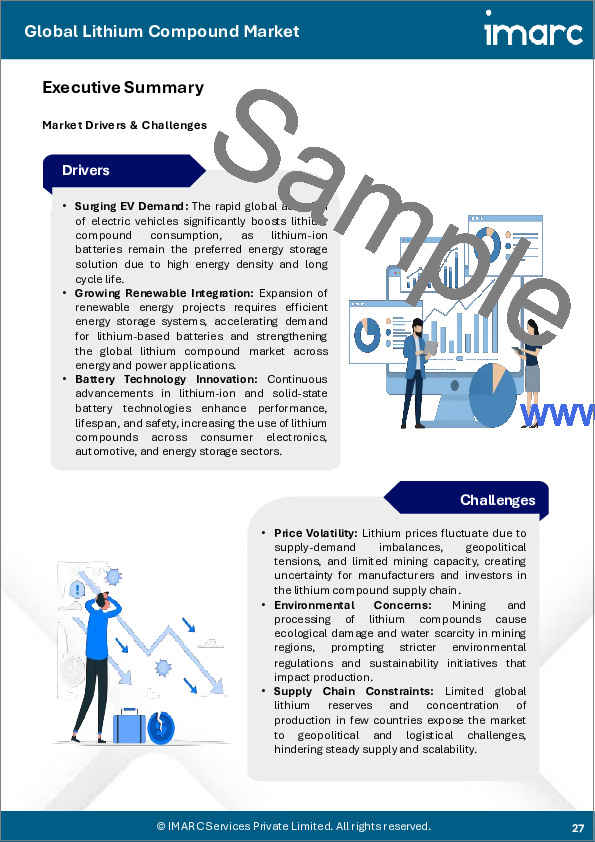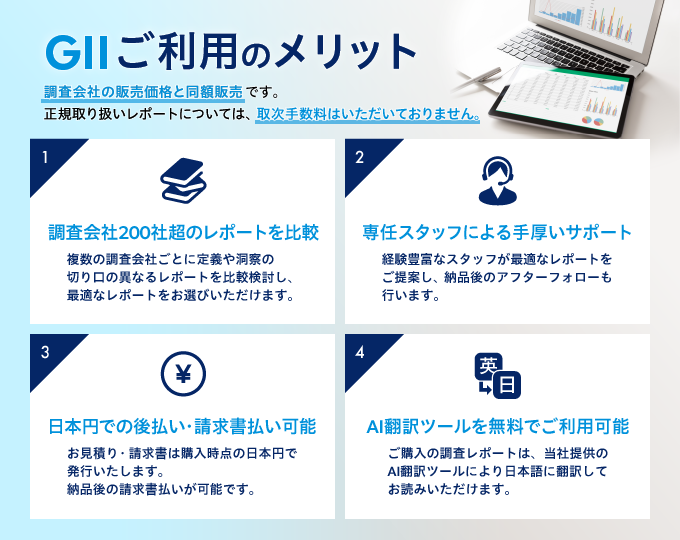|
|
市場調査レポート
商品コード
1792381
リチウム化合物の市場レポート:タイプ別、最終用途別、地域別、2025~2033年Lithium Compound Market Report by Type, End Use, and Region 2025-2033 |
||||||
カスタマイズ可能
|
|||||||
| リチウム化合物の市場レポート:タイプ別、最終用途別、地域別、2025~2033年 |
|
出版日: 2025年08月01日
発行: IMARC
ページ情報: 英文 140 Pages
納期: 2~3営業日
|
全表示
- 概要
- 図表
- 目次
世界のリチウム化合物の市場規模は2024年に62億米ドルに達しました。IMARC Groupは、2033年には114億米ドルに達し、2025~2033年の成長率(CAGR)は6.59%になると予測しています。電気自動車や再生可能エネルギー貯蔵におけるリチウムイオン電池の需要増加、家電製品の成長、電池技術における継続的な技術進歩は、市場を推進する主な要因の一部です。
リチウム化合物は、リチウムを主成分とする化合物です。軟質アルカリ金属であるリチウムは、その高い反応性により様々な化合物を形成します。一般的なリチウム化合物には、炭酸リチウム(Li2CO3)、水酸化リチウム(LiOH)、塩化リチウム(LiCl)、水素化アルミニウムリチウム(LiAlH4)などがあります。これらの化合物の用途は多様で、炭酸リチウムは携帯電子機器や電気自動車に不可欠なリチウムイオン電池の主要成分です。水酸化リチウムは、航空宇宙産業で宇宙船の空気から二酸化炭素を除去するために使用されています。このほか、リチウム化合物はそのユニークな特性から、医薬品やセラミックにも利用されています。
世界のリチウム化合物市場は、特に電気自動車(EV)や再生可能エネルギー分野など、様々な用途におけるリチウムイオン電池の需要増に牽引され、力強い成長を遂げています。リチウムイオン電池は、再生可能エネルギーを効率的に貯蔵・利用するために不可欠なものとなっており、世界がよりクリーンで持続可能なエネルギー源へと移行するにつれて、市場拡大の明るい見通しが生まれています。これと同時に、急成長する家電機器産業は、スマートフォン、ノートパソコン、その他のポータブル機器に電力を供給し、リチウム化合物の需要を刺激し続けています。さらに、グリッドエネルギー貯蔵システムやポータブル電子機器など、エネルギー効率の高い技術の採用拡大が市場の成長を後押ししています。これに加えて、リチウムイオン電池技術を改善し、耐久性と効率性を高めるための研究開発が進められていることも、市場の成長を支えています。さらに、EVや再生可能エネルギーの利用を奨励する政府の積極的な取り組みや政策が、リチウム化合物の市場拡大を後押しする良好な規制環境を生み出しています。
リチウム化合物市場の動向と促進要因:
リチウムイオン電池需要の急増
世界のリチウム化合物市場の最大の促進要因は、リチウムイオン電池の需要急増です。リチウムイオン電池は、エネルギー密度が高く、寿命が長く、環境に優しいため、広く採用されています。主な用途は電気自動車(EV)と再生可能エネルギー貯蔵システムです。特にEV市場は、世界各国が温室効果ガスの排出を削減するために、よりクリーンな交通手段を推進しているため、急速な成長を遂げています。その結果、炭酸リチウムや水酸化リチウムなどのリチウム化合物を必要とするリチウムイオン電池は、EV産業に不可欠な要素となっています。また、太陽光発電所や風力発電所のような再生可能エネルギー発電設備の拡大は、発電量が少ない期間に使用するための余剰エネルギーを貯蔵するためにリチウムイオン電池に大きく依存しており、リチウム化合物の需要をさらに促進しています。
家電製品における需要
世界の家電産業は、引き続きリチウム化合物の需要を牽引しています。リチウム化合物は、スマートフォン、ノートパソコン、タブレット端末、その他多くの携帯電子機器に使用されるリチウムイオン電池の製造に不可欠です。技術の進歩により、よりエネルギー効率が高く高性能な電子機器の開発が進むにつれて、リチウム化合物へのニーズは不変となり、市場拡大の好機となっています。これと相まって、新興市場における中流階級の人口増加と相まって、デジタル化の普及が進み、家電製品に対する需要が持続的に伸びていることが、リチウム化合物市場を支えています。
継続的な技術進歩
世界のリチウム化合物市場を促進するもう一つの重要な要因は、リチウムイオン電池技術を強化するための継続的な研究開発努力です。メーカーや研究者は、電池のエネルギー密度の向上、充電時間の短縮、電池寿命の延長に取り組んでいます。これらの技術革新は、リチウムイオン電池の全体的な効率を高め、航空宇宙、ヘルスケア、エネルギー貯蔵を含む様々な産業への適用を拡大し、市場拡大に貢献しています。さらに、リチウム化合物のリサイクルと持続可能な調達の進歩は、環境問題に対処し、これらの重要な材料の信頼できるサプライチェーンを確保します。このように、リチウムイオン電池産業における技術進歩への取り組みは、世界のリチウム化合物市場の持続的な促進要因となっており、技術革新と市場拡大を促進しています。
目次
第1章 序文
第2章 調査範囲と調査手法
- 調査の目的
- ステークホルダー
- データソース
- 一次情報
- 二次情報
- 市場推定
- ボトムアップアプローチ
- トップダウンアプローチ
- 調査手法
第3章 エグゼクティブサマリー
第4章 イントロダクション
- 概要
- プロパティ
- 主要業界動向
第5章 世界のリチウム化合物市場
- 市場概要
- 市場実績
- COVID-19の影響
- 価格動向
- 市場内訳:タイプ別
- 市場内訳:最終用途別
- 市場内訳:地域別
- 市場予測
- SWOT分析
- バリューチェーン分析
- ポーターのファイブフォース分析
第6章 市場内訳:タイプ別
- 炭酸リチウム
- 水酸化リチウム
- リチウム濃縮物
- 金属リチウム
- 塩化リチウム
- ブチルリチウム
- その他
第7章 市場内訳:最終用途別
- 電池
- ガラス・ガラスセラミック
- 自動車部品
- グリース
- 冶金
- ポリマー
- 空気処理
- その他
第8章 市場内訳:地域別
- アジア太平洋地域
- 北米
- 欧州
- 中東・アフリカ
- ラテンアメリカ
第9章 リチウム化合物の製造プロセス
- 製品概要
- 原材料の要件
- 製造プロセス
- 主要成功要因とリスク要因
第10章 競合情勢
- 市場構造
- 主要企業
- 主要企業のプロファイル
- SQM
- FMC Corporation
- Orocobre Limited
- Lithium Americas Corp.
- Neometals Ltd.
List of Figures
- Figure 1: Global: Lithium Compound Market: Major Drivers and Challenges
- Figure 2: Global: Lithium Compound Market: Sales Volume (in '000 Metric Tons), 2019-2024
- Figure 3: Global: Lithium Compound Market: Sales Value (in Billion USD), 2019-2024
- Figure 4: Global: Lithium Compound Market: Average Prices (in USD/Ton), 2019-2024
- Figure 5: Global: Lithium Compound Market: Breakup by Type (in %), 2024
- Figure 6: Global: Lithium Compound Market: Breakup by End Use (in %), 2024
- Figure 7: Global: Lithium Compound Market: Breakup by Region (in %), 2024
- Figure 8: Global: Lithium Compound Market Forecast: Sales Volume (in '000 Metric Tons), 2025-2033
- Figure 9: Global: Lithium Compound Market Forecast: Sales Value (in Billion USD), 2025-2033
- Figure 10: Global: Lithium Compound Industry: SWOT Analysis
- Figure 11: Global: Lithium Compound Industry: Value Chain Analysis
- Figure 12: Global: Lithium Compound Industry: Porter's Five Forces Analysis
- Figure 13: Global: Lithium Carbonate Market: Sales Volume (in '000 Metric Tons), 2019 & 2024
- Figure 14: Global: Lithium Carbonate Market Forecast: Sales Volume (in '000 Metric Tons), 2025-2033
- Figure 15: Global: Lithium Hydroxide Market: Sales Volume (in '000 Metric Tons), 2019 & 2024
- Figure 16: Global: Lithium Hydroxide Market Forecast: Sales Volume (in '000 Metric Tons), 2025-2033
- Figure 17: Global: Lithium Concentrate Market: Sales Volume (in '000 Metric Tons), 2019 & 2024
- Figure 18: Global: Lithium Concentrate Market Forecast: Sales Volume (in '000 Metric Tons), 2025-2033
- Figure 19: Global: Lithium Metal Market: Sales Volume (in '000 Metric Tons), 2019 & 2024
- Figure 20: Global: Lithium Metal Market Forecast: Sales Volume (in '000 Metric Tons), 2025-2033
- Figure 21: Global: Lithium Chloride Market: Sales Volume (in '000 Metric Tons), 2019 & 2024
- Figure 22: Global: Lithium Chloride Market Forecast: Sales Volume (in '000 Metric Tons), 2025-2033
- Figure 23: Global: Butyllithium Market: Sales Volume (in '000 Metric Tons), 2019 & 2024
- Figure 24: Global: Butyllithium Market Forecast: Sales Volume (in '000 Metric Tons), 2025-2033
- Figure 25: Global: Other Lithium Compound Market: Sales Volume (in '000 Metric Tons), 2019 & 2024
- Figure 26: Global: Other Lithium Compound Market Forecast: Sales Volume (in '000 Metric Tons), 2025-2033
- Figure 27: Global: Lithium Compound Market (Applications in Batteries): Sales Volume (in '000 Metric Tons), 2019 & 2024
- Figure 28: Global: Lithium Compound Market Forecast (Applications in Batteries): Sales Volume (in '000 Metric Tons), 2025-2033
- Figure 29: Global: Lithium Compound Market (Applications in Glass and Glass Ceramics): Sales Volume (in '000 Metric Tons), 2019 & 2024
- Figure 30: Global: Lithium Compound Market Forecast (Applications in Glass and Glass Ceramics): Sales Volume (in '000 Metric Tons), 2025-2033
- Figure 31: Global: Lithium Compound Market (Applications in Automotive Parts): Sales Volume (in '000 Metric Tons), 2019 & 2024
- Figure 32: Global: Lithium Compound Market Forecast (Applications in Automotive Parts): Sales Volume (in '000 Metric Tons), 2025-2033
- Figure 33: Global: Lithium Compound Market (Applications in Greases): Sales Volume (in '000 Metric Tons), 2019 & 2024
- Figure 34: Global: Lithium Compound Market Forecast (Applications in Greases): Sales Volume (in '000 Metric Tons), 2025-2033
- Figure 35: Global: Lithium Compound Market (Applications in Metallurgy): Sales Volume (in '000 Metric Tons), 2019 & 2024
- Figure 36: Global: Lithium Compound Market Forecast (Applications in Metallurgy): Sales Volume (in '000 Metric Tons), 2025-2033
- Figure 37: Global: Lithium Compound Market (Applications in Polymer): Sales Volume (in '000 Metric Tons), 2019 & 2024
- Figure 38: Global: Lithium Compound Market Forecast (Applications in Polymer): Sales Volume (in '000 Metric Tons), 2025-2033
- Figure 39: Global: Lithium Compound Market (Applications in Air Treatment): Sales Volume (in '000 Metric Tons), 2019 & 2024
- Figure 40: Global: Lithium Compound Market Forecast (Applications in Air Treatment): Sales Volume (in '000 Metric Tons), 2025-2033
- Figure 41: Global: Lithium Compound Market (Other Applications): Sales Volume (in '000 Metric Tons), 2019 & 2024
- Figure 42: Global: Lithium Compound Market Forecast (Other Applications): Sales Volume (in '000 Metric Tons), 2025-2033
- Figure 43: Asia Pacific: Lithium Compound Market: Sales Volume (in '000 Metric Tons), 2019 & 2024
- Figure 44: Asia Pacific: Lithium Compound Market Forecast: Sales Volume (in '000 Metric Tons), 2025-2033
- Figure 45: North America: Lithium Compound Market: Sales Volume (in '000 Metric Tons), 2019 & 2024
- Figure 46: North America: Lithium Compound Market Forecast: Sales Volume (in '000 Metric Tons), 2025-2033
- Figure 47: Europe: Lithium Compound Market: Sales Volume (in '000 Metric Tons), 2019 & 2024
- Figure 48: Europe: Lithium Compound Market Forecast: Sales Volume (in '000 Metric Tons), 2025-2033
- Figure 49: Middle East and Africa: Lithium Compound Market: Sales Volume (in '000 Metric Tons), 2019 & 2024
- Figure 50: Middle East and Africa: Lithium Compound Market Forecast: Sales Volume (in '000 Metric Tons), 2025-2033
- Figure 51: Latin America: Lithium Compound Market: Sales Volume (in '000 Metric Tons), 2019 & 2024
- Figure 52: Latin America: Lithium Compound Market Forecast: Sales Volume (in '000 Metric Tons), 2025-2033
- Figure 53: Lithium Compound Manufacturing: Detailed Process Flow
List of Tables
- Table 1: Lithium Compound: General Properties
- Table 2: Global: Lithium Compound Market: Key Industry Highlights, 2024 and 2033
- Table 3: Global: Lithium Compound Market Forecast: Breakup by Type (in '000 Metric Tons), 2025-2033
- Table 4: Global: Lithium Compound Market Forecast: Breakup by End Use (in '000 Metric Tons), 2025-2033
- Table 5: Global: Lithium Compound Market Forecast: Breakup by Region (in '000 Metric Tons), 2025-2033
- Table 6: Lithium Compound Manufacturing: Raw Material Requirements
- Table 7: Global: Lithium Compound Market: Competitive Structure
- Table 8: Global: Lithium Compound Market: Key Players
The global lithium compound market size reached USD 6.2 Billion in 2024. Looking forward, IMARC Group expects the market to reach USD 11.4 Billion by 2033, exhibiting a growth rate (CAGR) of 6.59% during 2025-2033. The increasing demand for lithium-ion batteries in electric vehicles, renewable energy storage, growing consumer electronics, and ongoing technological advancements in battery technology are some of the major factors propelling the market.
Lithium compounds are chemical compounds containing lithium as a primary constituent. Lithium, a soft alkali metal, forms various compounds due to its high reactivity. Common lithium compounds include lithium carbonate (Li2CO3), lithium hydroxide (LiOH), lithium chloride (LiCl), and lithium aluminum hydride (LiAlH4). These compounds have diverse applications, with lithium carbonate being a key component in lithium-ion batteries, essential for portable electronic devices and electric vehicles. Lithium hydroxide is used in the aerospace industry to remove carbon dioxide from the air in spacecraft. Besides this, lithium compounds find use in pharmaceuticals and ceramics due to their unique properties.
The global lithium compound market is experiencing robust growth driven by the increasing demand for lithium-ion batteries in various applications, particularly in the electric vehicle (EV) and renewable energy sectors. Lithium-ion batteries have become indispensable for storing and utilizing renewable energy efficiently, creating a positive outlook for market expansion as the world transitions towards cleaner and more sustainable energy sources. Concurrent with this, the burgeoning consumer electronics industry continues to fuel demand for lithium compounds, powering smartphones, laptops, and other portable devices. Moreover, the expanding adoption of energy-efficient technologies, such as grid energy storage systems and portable electronic gadgets, is bolstering the market growth. In addition to this, ongoing research and development (R&D) efforts to improve lithium-ion battery technology, making them more durable and efficient, are supporting the market growth. Furthermore, favorable governmental initiatives and policies encouraging the use of EVs and renewable energy sources are creating a favorable regulatory environment, encouraging market expansion for lithium compounds.
Lithium Compound Market Trends/Drivers:
Surging demand for lithium-ion batteries
The foremost driver of the global lithium compound market is the escalating demand for lithium-ion batteries. These batteries have gained widespread adoption due to their high energy density, longer lifespan, and eco-friendliness. Their primary applications are in electric vehicles (EVs) and renewable energy storage systems. The EV market, in particular, has been experiencing rapid growth as countries worldwide promote cleaner transportation options to reduce greenhouse gas emissions. As a result, lithium-ion batteries, which require lithium compounds such as lithium carbonate and hydroxide, have become integral components of the EV industry. Apart from this, the expansion of renewable energy installations, such as solar and wind farms, relies heavily on lithium-ion batteries to store excess energy for use during periods of low energy generation, further propelling the demand for lithium compounds.
Pervasive consumer electronics market
The global consumer electronics industry continues to drive the demand for lithium compounds. These compounds are essential in manufacturing lithium-ion batteries used in smartphones, laptops, tablets, and an array of portable electronic devices. As technological advancements lead to the development of more energy-efficient and high-performance electronic gadgets, the need for lithium compounds remains constant, which, in turn, presents remunerative opportunities for market expansion. In confluence with this, the increasing prevalence of digitalization, coupled with the rising middle-class population in emerging markets, contributes to the sustained growth in demand for consumer electronics, thereby supporting the lithium compound market.
Ongoing technological advancements
Another critical factor fueling the global lithium compound market is the continuous R&D efforts to enhance lithium-ion battery technology. Manufacturers and researchers are working on improving battery energy density, reducing charging times, and extending battery lifespan. These innovations increase the overall efficiency of lithium-ion batteries and expand their applicability to various industries, including aerospace, healthcare, and energy storage, thereby aiding in market expansion. Furthermore, advancements in recycling and sustainable sourcing of lithium compounds address environmental concerns and ensure a reliable supply chain for these critical materials. As such, the commitment to technological progress within the lithium-ion battery sector serves as a persistent driver for the global lithium compound market, fostering innovation and market expansion.
Lithium Compound Industry Segmentation:
Breakup by Type:
- Lithium Carbonate
- Lithium Hydroxide
- Lithium Concentrate
- Lithium Metal
- Lithium Chloride
- Butyllithium
- Other Lithium Compounds
Lithium carbonate dominates the market
The growing demand for lithium carbonate is primarily propelled by its crucial role in the manufacturing of lithium-ion batteries, specifically for electric vehicles (EVs) and renewable energy storage systems. With the expanding global shift towards clean energy and sustainable transportation, the demand for lithium-ion batteries continues to soar. Lithium carbonate is a crucial component in the cathode material of these batteries, and its high energy density and thermal stability make it indispensable for such applications, boosting the product demand. Additionally, the rise of energy storage solutions for renewable sources such as solar and wind power has increased the need for large-scale lithium-ion batteries, contributing to the increasing demand for lithium carbonate. Moreover, ongoing advancements in lithium-ion battery technology, such as efforts to enhance energy efficiency and reduce charging times, driving up the demand for high-quality lithium carbonate to meet stringent performance requirements, are propelling the market forward.
Breakup by End Use:
- Batteries
- Glass and Glass Ceramics
- Automotive Parts
- Greases
- Metallurgy
- Polymer
- Air Treatment
- Others
Batteries hold the largest share of the market
The expanding market for energy storage solutions, driven by the increasing integration of renewable energy such as solar and wind into the grid, is fueling demand for lithium compounds in batteries, particularly lithium-ion batteries. These intermittent energy sources require efficient and reliable energy storage systems, where lithium compounds play a pivotal role due to their high energy density and long cycle life. Moreover, the electrification of various sectors, including transportation and industrial applications, is bolstering the demand for lithium-ion batteries, creating a robust market for lithium compounds. Furthermore, the evolution of portable electronic devices and the Internet of Things (IoT) ecosystem continue to generate substantial demand, as lithium-ion batteries are the preferred power source due to their lightweight nature and high energy efficiency.
Breakup by Region:
- Asia Pacific
- North America
- Europe
- Middle East and Africa
- Latin America
Asia Pacific exhibits a clear dominance, accounting for the largest lithium compound market share
The market research report has also provided a comprehensive analysis of all the major regional markets, which include Asia Pacific, Europe, North America, Latin America, and the Middle East and Africa. According to the report, Asia Pacific accounted for the largest market share.
The Asia Pacific lithium compound market is experiencing significant growth driven by the rapid expansion of the electric vehicle (EV) market in countries such as China, India, and South Korea. Governments in these nations are actively promoting electric mobility to combat pollution and reduce reliance on fossil fuels, leading to an escalating demand for lithium-ion batteries and, consequently, lithium compounds. Furthermore, the Asia Pacific region is witnessing substantial growth in the consumer electronics industry, with a burgeoning middle-class population and increasing digitalization trends. This has resulted in heightened demand for portable electronic devices, further impelling the need for lithium compounds used in battery production. Apart from this, the region's aggressive push toward renewable energy sources have created a thriving market for lithium-ion batteries in energy storage applications, supporting the growth of the lithium compound market.
Competitive Landscape:
The competitive landscape of the global lithium compound market is characterized by strong competition among key players and a growing number of emerging entrants. Established lithium compound manufacturers dominate the market, benefiting from their extensive production capacities and global supply chains. However, the market is witnessing increased competition from newer entrants, both domestic and international, who are seeking to capitalize on the surging demand for lithium compounds. These entrants are often focused on niche markets, innovative technologies, or sustainable sourcing practices, challenging the established players. Moreover, strategic collaborations, mergers, and acquisitions are prevalent strategies among market participants to strengthen their positions, expand product portfolios, and secure access to critical resources, intensifying competition in the global lithium compound market.
The report has provided a comprehensive analysis of the competitive landscape in the market. Detailed profiles of all major companies have also been provided. Some of the key players in the market include:
- SQM S.A.
- FMC Corporation
- Orocobre Limited
- Lithium Americas Corp.
- Neometals Ltd.
Key Questions Answered in This Report
- 1.What was the size of the global lithium compound market in 2024?
- 2.What is the expected growth rate of the global lithium compound market during 2025-2033?
- 3.What has been the impact of COVID-19 on the global lithium compound market?
- 4.What are the key factors driving the global lithium compound market?
- 5.What is the breakup of the global lithium compound market based on the type?
- 6.What is the breakup of the global lithium compound market based on the end use?
- 7.What are the key regions in the global lithium compound market?
- 8.Who are the key players/companies in the global lithium compound market?
Table of Contents
1 Preface
2 Scope and Methodology
- 2.1 Objectives of the Study
- 2.2 Stakeholders
- 2.3 Data Sources
- 2.3.1 Primary Sources
- 2.3.2 Secondary Sources
- 2.4 Market Estimation
- 2.4.1 Bottom-Up Approach
- 2.4.2 Top-Down Approach
- 2.5 Forecasting Methodology
3 Executive Summary
4 Introduction
- 4.1 Overview
- 4.2 Properties
- 4.3 Key Industry Trends
5 Global Lithium Compound Market
- 5.1 Market Overview
- 5.2 Market Performance
- 5.2.1 Volume Trends
- 5.2.2 Value Trends
- 5.3 Impact of COVID-19
- 5.4 Price Trends
- 5.5 Market Breakup by Type
- 5.6 Market Breakup by End Use
- 5.7 Market Breakup by Region
- 5.8 Market Forecast
- 5.9 SWOT Analysis
- 5.9.1 Overview
- 5.9.2 Strengths
- 5.9.3 Weaknesses
- 5.9.4 Opportunities
- 5.9.5 Threats
- 5.10 Value Chain Analysis
- 5.10.1 Overview
- 5.10.2 Research and Development
- 5.10.3 Raw Material Procurement
- 5.10.4 Manufacturing
- 5.10.5 Marketing
- 5.10.6 Distribution
- 5.10.7 End-Use
- 5.11 Porters Five Forces Analysis
- 5.11.1 Overview
- 5.11.2 Bargaining Power of Buyers
- 5.11.3 Bargaining Power of Suppliers
- 5.11.4 Degree of Competition
- 5.11.5 Threat of New Entrants
- 5.11.6 Threat of Substitutes
6 Market Breakup by Type
- 6.1 Lithium Carbonate
- 6.1.1 Market Trends
- 6.1.2 Market Forecast
- 6.2 Lithium Hydroxide
- 6.2.1 Market Trends
- 6.2.2 Market Forecast
- 6.3 Lithium Concentrate
- 6.3.1 Market Trends
- 6.3.2 Market Forecast
- 6.4 Lithium Metal
- 6.4.1 Market Trends
- 6.4.2 Market Forecast
- 6.5 Lithium Chloride
- 6.5.1 Market Trends
- 6.5.2 Market Forecast
- 6.6 Butyllithium
- 6.6.1 Market Trends
- 6.6.2 Market Forecast
- 6.7 Other Lithium Compounds
- 6.7.1 Market Trends
- 6.7.2 Market Forecast
7 Market Breakup by End Use
- 7.1 Batteries
- 7.1.1 Market Trends
- 7.1.2 Market Forecast
- 7.2 Glass and Glass Ceramics
- 7.2.1 Market Trends
- 7.2.2 Market Forecast
- 7.3 Automotive Parts
- 7.3.1 Market Trends
- 7.3.2 Market Forecast
- 7.4 Greases
- 7.4.1 Market Trends
- 7.4.2 Market Forecast
- 7.5 Metallurgy
- 7.5.1 Market Trends
- 7.5.2 Market Forecast
- 7.6 Polymer
- 7.6.1 Market Trends
- 7.6.2 Market Forecast
- 7.7 Air Treatment
- 7.7.1 Market Trends
- 7.7.2 Market Forecast
- 7.8 Others
- 7.8.1 Market Trends
- 7.8.2 Market Forecast
8 Market Breakup by Region
- 8.1 Asia Pacific
- 8.1.1 Market Trends
- 8.1.2 Market Forecast
- 8.2 North America
- 8.2.1 Market Trends
- 8.2.2 Market Forecast
- 8.3 Europe
- 8.3.1 Market Trends
- 8.3.2 Market Forecast
- 8.4 Middle East and Africa
- 8.4.1 Market Trends
- 8.4.2 Market Forecast
- 8.5 Latin America
- 8.5.1 Market Trends
- 8.5.2 Market Forecast
9 Lithium Compound Manufacturing Process
- 9.1 Product Overview
- 9.2 Raw Material Requirements
- 9.3 Manufacturing Process
- 9.4 Key Success and Risk Factors
10 Competitive Landscape
- 10.1 Market Structure
- 10.2 Key Players
- 10.3 Profiles of Key Players
- 10.3.1 SQM
- 10.3.1.1 Company Overview
- 10.3.1.2 Description
- 10.3.1.3 Product Portfolio
- 10.3.1.4 Financials
- 10.3.1.5 SWOT Analysis
- 10.3.2 FMC Corporation
- 10.3.2.1 Company Overview
- 10.3.2.2 Description
- 10.3.2.3 Product Portfolio
- 10.3.2.4 Financials
- 10.3.2.5 SWOT Analysis
- 10.3.3 Orocobre Limited
- 10.3.3.1 Company Overview
- 10.3.3.2 Description
- 10.3.3.3 Product Portfolio
- 10.3.3.4 Financials
- 10.3.4 Lithium Americas Corp.
- 10.3.4.1 Company Overview
- 10.3.4.2 Description
- 10.3.4.3 Product Portfolio
- 10.3.5 Neometals Ltd.
- 10.3.5.1 Company Overview
- 10.3.5.2 Description
- 10.3.5.3 Product Portfolio
- 10.3.5.4 Financials
- 10.3.1 SQM





